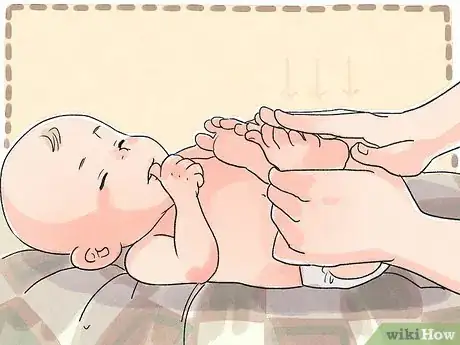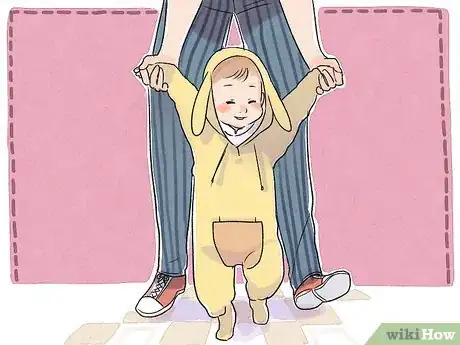This article was co-authored by Sylvia Rath. Sylvia Rath is a Parenting Specialist and the Director of Little Village Nursery School in Los Angeles, California. With over 30 years of experience, Sylvia guides parents through the preschool years and beyond by teaching respectful communication and positive discipline methods. Sylvia holds a BA in Psychology and Early Child Development from Antioch University. Before working at Little Village Nursery School, she taught preschool for eight years.
This article has been viewed 72,026 times.
Dealing with a fussy baby is never easy for parents. There can be no worse feeling in the world than seeing that your child is upset and feeling like you don't know how to make it better. However, if you try a variety of strategies and are attentive to your baby's needs, you'll be able to calm your fussy baby in no time at all.
Steps
Using Various Soothing Strategies
-
1Calm your baby with gentle motion. Gentle motion can help calm your fussy baby and may even put him/her right to sleep. Though different forms of motion work best for different babies, you can try a variety of strategies to see what's best for your baby. Though you may be used to the image of a mother and father rocking their children, just make sure you don't put your baby in motion for so long that you get tired. Try some of these motion techniques to help calm your fussy baby:[1]
- Bounce and/or rock the baby in your arms
- Gently pat the baby's back
- Hold your baby while rocking in a rocking chair
- Go for a walk with your baby
- Place the baby in a swing
- Place your baby on your knees and gently sway him/her from side to side
- Rock your baby in a cradle if you have one
- Sit on an exercise ball and bounce up and down while holding your baby
- Sway with the baby in your arms
- Take the baby for a car ride
- Walk slowly around the room with your baby
-
2Enable side lying in your arms. Side lying can be another source of calm and comfort for your baby. To do it properly, just hold your baby at an angle and allow him/her to be on a side. Your baby can stop being fussy simply by changing the way that he/she is lying down. You can do this in your arms as long as you avoid placing the baby on his/her side in his/her crib, or this can cause him/her to roll over on his/her stomach, which will increase the risk of Sudden Infant Death Syndrome (SIDS).[2]Advertisement
-
3Make a soothing noise. Making a soothing noise can really help your baby calm down and be less fussy. Just hearing a new sound can make your baby interested and alert and can help alleviate the pain he/she was feeling earlier. You can use your surroundings to find an appropriate noise or sound or you can even do the work yourself. Here are some sounds that may help calm down your fussy baby:
- Turning on a white noise machine
- Soft singing
- Humming
- Turning the radio on static
- Turning on the vacuum in the other room
- Running a faucet
- Playing soft music
- Playing nature sounds
-
4Swaddle your baby. Swaddling is a great way to calm your fussy baby; this is because your baby felt warm and comfortable in your womb and swaddling your baby can help mimic this safe feeling. To swaddle your baby, you should use a small and lightweight blanket, helping your baby stay tucked in so he/she doesn't disturb himself/herself by flailing his/her limbs around. To keep your baby safe from SIDS or from having trouble breathing, it's important to make sure that your baby isn't swaddled too tight and that he/she is placed on his/her back; you should also avoid swaddling your baby with a pacifier to avoid choking and making sure your baby can breathe. Here's how you should go about swaddling your baby:[3] [4]
- Lay out the blanket on a flat surface.
- Fold down one of the corners and place the baby's head over the fold.
- Wrap one side of the blanket around the baby, pinning his/her arm down.
- Take the point below your baby's feet and pull it up, tucking it into the top of the blanket point that was tightly wound around.
- Take the other side of the blanket and wrap it around your baby so his/her other arm is firmly tucked in.
-
5Give your baby a warm bath. A warm bath can be the perfect soothing technique for some babies. It can help get them ready for a nap or just relax them and make them feel less tense, just as a warm bath has been proven to help many adults relieve tension in the past. Though this doesn't work for all babies, you can try it to see if it has a positive impact on your child. Unfortunately, some babies actually get agitated after warm baths, so be vigilant when you do try this technique to see the effect it's really having on your baby.
-
6Give your baby something to suck on. If your baby is fussy, then he/she may be wanting something to suck on. He/she may not need a breast or a bottle but you can find something else to do the trick. You can give him/her a pacifier, put his/her thumb in his/her mouth, or even give him/her your pinkie nail, with the nail side down. Your baby may feel comforted from these simple offerings.
-
7Give your baby a massage. Another thing you can do is to gently massage your baby's body. Touch his/her palms, the pads of his/her feet, his/her shoulders, and the rest of his/her body gently so that he/she is soothed by your loving touch. You can just use the pads of your fingers to gently massage your baby, helping ease the tension that he/she is feeling.[5]
- Just remember that, much like a warm bath, some babies can actually be more agitated after a massage, so you should be vigilant when you try it so you see how your baby feels.
-
8Give your baby a change of scenery. Your baby may very well be fussy because he/she just wants a change of scenery. Changing your scenery, whether you move to a different room or add some exciting elements to the room you're in, can give your baby something else to pay attention to and can take his/her mind off of his/her agitation. If you don't have the energy for anything too elaborate, you can simply move to a different room or stand near the window and face the outdoors. Here are some other tricks you can try to mix things up for your baby:
- Look at your fish tank, a bright painting, or anything else exciting in your environment
- Turn on your overhead fan
- Dim the lights
- Move to your backyard or front porch
- Give your baby a new toy
-
9Try shushing your baby. Sometimes babies end up making themselves more upset by their own loud tears. You can help calm them down by getting them to be quieter until their tears and fussiness stops all together. To do this, you can gently shush your baby in a sweet, calm way — as opposed to the way a student might be shushed by a librarian. In order to shush your baby, you should simply softly speak or shush just a bit louder than your baby and then slowly lower the volume of your voice until your baby's voice matches yours.
Making Sure Your Baby's Needs Are Met
-
1Does your baby need burping? Babies are gassier than adults, and this can lead to pain and discomfort. a. To burp your baby, all you have to do is hold him/her in your left arm, having the side of his/her face on your shoulder. Then, pat your baby's back gently until you hear a burp. Rubbing your baby's back from the bottom upward can also help ease your baby's pain. But just picking up your baby will often help.[6]
-
2Make sure your baby's clothes are comfortable. Make sure that the clothes are not too tight or pinching your child. Tags or seams may be another issue. Make sure that the clothes are of a comfortable material.
- Additionally, your baby may be feeling too hot or cold in the clothes. Feel your baby's skin and make sure this isn't a factor.
-
3Make sure your baby isn't upset by a change in routine. Your baby may just be fussy because you are doing something new and he/she doesn't like it. Maybe you switched to a different brand of formula, maybe you took your baby for a walk earlier than usual, or maybe you're spending time in a new part of the house your baby isn't used to. Though you can't stick to the same routine forever, you should note that this can be contributing to the baby's fussiness.
- If you're trying to make a change, you can try to ease the baby into it, by going for a walk 15 minutes earlier every day instead of taking a walk 2 hours earlier one day, for example.
-
4Make sure your baby isn't simply tired. One reason for your baby to be fussy is just that he/she may be tired. If you see him/her yawning or just seeming restless, then put him/her down for a nap. Your baby may not be aware of the fact that he/she needs more rest, but you should let him/her calm down, turn off the lights, and soothe him/her until he/she is ready for sleep.
- Even if your baby is acting very fussy and is active, this may be a sign that he/she feels overworked and needs some help calming down.
-
5Give the baby less stimulation if he/she is overwhelmed. Another reason why your baby may be fussy is because there may be too much going on at home. Maybe you have a loud TV or music on, maybe the lights are too bright, maybe there are too many people around or maybe there are just too many toys in your baby's crib. This is a major reason for a baby to get fussy, and if you suspect that this is the case, then you may need to simplify things and reduce the noise and excitement around the house for a while to calm your fussy baby.[7]
- See what an impact turning down the sound or the lights may have on your baby. You'd be surprised by how much better your baby may instantly feel.
- If you are introducing new people to the baby, try to do it one at a time in a calm, gentle way. Your baby is likely to feel overwhelmed and fussy if there are ten new relatives hovering over him all at once. Or it is in the middle of a loud restaurant rather than a quiet living room.
-
6Give the baby more affection if he/she feels neglected. One reason why your baby might be crying or wailing is simply because he/she is feeling neglected and wants more attention. This can happen if your baby has been alone for a while, if you haven't made physical contact for a few hours, or if you're just not giving your child enough time. If this is the case, then you should hold, kiss, hug, or just spend time with your baby. This can help ease the fussiness pretty quickly, if this is your baby's reason for being upset.[8]
- If your baby is crying, ask yourself when the last time you held your baby was. If more than a few hours have passed, then you should give your baby more physical affection immediately.
-
7See if you can distinguish between your baby's cries. Not all cries should be treated alike. This takes time and attention, but as you get to know your fussy baby, you will be able to distinguish between his/her various cries. One cry may mean he/she is hungry, while another may let you know he/she is wet. Though each baby is different, it is important to know that hungry babies tend to quietly fuss and squirm, and to escalate their cries as their hunger increases. A baby who is feeling pain, whether it's from illness, gas, or teething, will have a more piercing cry along with a pained look.
- The more attuned you are to your baby's needs and to what he/she is telling you, the more easily you'll be able to soothe your baby.
-
8See if your baby has colic. Babies who have colic tend to cry and to be in consistent discomfort from 2 weeks after they are born until 12-14 weeks past their due date. You can tell if your baby has colic if his/her cries are high-pitched, frantic, or sudden, and if he/she cries with a rigid or stiff body with clenched fists and a look of pain or anger on his/her face. After about 6 weeks, the colic should reach its height and should slowly taper off or even end abruptly after that. Though this can be a frustrating experience for parents and babies alike, you should know that it will pass.[9]
- You can talk to a pediatrician about the colic, but unfortunately, there is no real cure. The most the doctor may do is to recommend gripe water or mylicon drops for your child. You will also be told to have patience, even if that's not what you wanted to hear.
- You can also talk to your doctor about other problems that could be causing your child to cry, such as your diet if you're breastfeeding, acid reflux, or allergies to certain food.
Knowing What Not to Do
-
1Never, ever, ever shake your baby. Though you may get frustrated with your baby from time to time, the worst thing you can do is to shake him/her. Even shaking your baby for just a few seconds can cause damage that cannot be undone. If you feel yourself truly losing patience with your child, take a few seconds or minutes to leave the room until you feel that you can safely return to your baby. If you have a real problem with anger toward your baby, see a doctor immediately to keep your baby safe.
- Over 1000 babies die a year from Shaken Baby Syndrome. It is 100% preventable. Shaking your baby can lead to death, brain damage, mental disabilities, seizures, and even blindness.
-
2Avoid "letting them cry it out". A common piece of advice for many women in older generations was to not rush in to soothe every cry--that the child needs to deal with it. But today's general advice is that children under 1 or so are crying because something is wrong. The baby is helpless, and looks to you for help. Ignoring the baby's cries with the idea that "they will be spoiled if you do" does no one any good.
- Avoid letting your baby cry and cry, but sometimes you will find yourself unable to discover why the baby is crying. This can be upsetting to everyone. But the good news is that rarely do these episodes cause any lasting harm, either. Sometimes you never will find out why all the crying, and it is OK. Life goes on.
- Sometimes you cannot immediately soothe a baby. Sometimes you cannot feed a baby immediately, or change his/her diaper, or give him/her attention. For example, you are driving home and cannot pull over to feed your baby. It may make him/her upset, but these situations occur and human babies will survive if you cannot drop everything immediately and remedy the situation.
- If you are overwhelmed as a caregiver, when these crying jags occur it is OK to sometimes take a few minutes to yourself. Take a quick shower. Call your mother. These times can cause even the most loving mother or father to feel short-tempered. Sometimes stepping away for a few moments can really help you deal with this sort of situation.
-
3Do not mindlessly use the pacifier. Popping in a pacifier when your baby is crying or upset may be a great temporary fix for your baby's problems. And to be fair, many pediatricians are fine with moderate pacifier use. However, using it too much gets to be a bad habit to break later. And you, as caregiver, may not figure out what is really wrong.
-
4Try one soothing method at a time. If your baby is crying and you try feeding him/her, give him/her a pacifier, going for a walk, and rocking him/her all in the same fifteen-minute span, then you may overwhelm her rather than make things better.
- Try your calming methods one at a time until you have a strong sense of what really works. You may be surprised to find that you did not need to go outside or bring out that new toy all along.
-
5Do not necessarily feed your baby the second crying starts. If it is near a typical feeding time, it is pretty likely your child is hungry. However, if you feed your baby whenever he/she cries, even if he/she is been recently fed, then this may lead him/her to look at food as the greatest source of comfort. This can lead to overeating and problems down the line.
Expert Q&A
-
QuestionWhat advice do you have for calming down a toddler tantrum?
 Sylvia RathSylvia Rath is a Parenting Specialist and the Director of Little Village Nursery School in Los Angeles, California. With over 30 years of experience, Sylvia guides parents through the preschool years and beyond by teaching respectful communication and positive discipline methods. Sylvia holds a BA in Psychology and Early Child Development from Antioch University. Before working at Little Village Nursery School, she taught preschool for eight years.
Sylvia RathSylvia Rath is a Parenting Specialist and the Director of Little Village Nursery School in Los Angeles, California. With over 30 years of experience, Sylvia guides parents through the preschool years and beyond by teaching respectful communication and positive discipline methods. Sylvia holds a BA in Psychology and Early Child Development from Antioch University. Before working at Little Village Nursery School, she taught preschool for eight years.
Parenting Specialist Use reflective listening and empathy so your child knows they have been heard. Try not to overtalk it. You can use your own imagination like, “I wish we had a chocolate cookie too! I would love cookies for breakfast lunch and dinner, but should I do that?” Some children simply need time to cool down, some could use a hug, just remember who the toddler is and try to stay calm. Be the model and guide. Take a breath and try not to overreact.
Use reflective listening and empathy so your child knows they have been heard. Try not to overtalk it. You can use your own imagination like, “I wish we had a chocolate cookie too! I would love cookies for breakfast lunch and dinner, but should I do that?” Some children simply need time to cool down, some could use a hug, just remember who the toddler is and try to stay calm. Be the model and guide. Take a breath and try not to overreact. -
QuestionWhat if my baby cries for no reason?
 Amy PaigeCommunity AnswerIf a baby cries for seemingly no reason, she may be too hot or cold, hungry, or just exercising her voice. Babies don't have a whole lot of ways to say anything, so they often just cry because that's all they can do. A good way to try and deal with this is to try giving your baby a favorite toy or extra attention.
Amy PaigeCommunity AnswerIf a baby cries for seemingly no reason, she may be too hot or cold, hungry, or just exercising her voice. Babies don't have a whole lot of ways to say anything, so they often just cry because that's all they can do. A good way to try and deal with this is to try giving your baby a favorite toy or extra attention. -
QuestionWhat can I do if my baby cries every time I take is pacifier away and put him down for a nap? I try comforting him but he won't stop crying.
 FlowieCommunity AnswerAll babies need to learn to comfort themselves! Try this: put him down for a nap, then set a timer (use the one in your phone or the one on your oven) for three minutes. If he doesn't stop crying after three minutes, pick him up. Next time set the timer for four minutes. If he doesn't stop crying in four minutes, set the timer for five minutes the next time. You can keep going like that for as long as it takes, but I bet he'll be putting himself to sleep by the third try.
FlowieCommunity AnswerAll babies need to learn to comfort themselves! Try this: put him down for a nap, then set a timer (use the one in your phone or the one on your oven) for three minutes. If he doesn't stop crying after three minutes, pick him up. Next time set the timer for four minutes. If he doesn't stop crying in four minutes, set the timer for five minutes the next time. You can keep going like that for as long as it takes, but I bet he'll be putting himself to sleep by the third try.
Warnings
- Never ignore your baby's crying hoping that it will just stop. It may be something serious.⧼thumbs_response⧽
References
- ↑ http://www.healthychildren.org/English/ages-stages/baby/crying-colic/Pages/Calming-A-Fussy-Baby.aspx
- ↑ http://www.healthychildren.org/English/ages-stages/baby/crying-colic/Pages/Calming-A-Fussy-Baby.aspx
- ↑ http://www.parenting.com/gallery/how-to-swaddle-a-baby
- ↑ http://www.parents.com/baby/care/newborn/ways-to-soothe-fussy-newborn/
- ↑ http://www.babycenter.com/0_what-i-wish-id-known-about-soothing-a-fussy-baby_1468908.bc
- ↑ http://www.babycenter.com/0_12-reasons-babies-cry-and-how-to-soothe-them_9790.bc?page=2
- ↑ http://www.babycenter.com/0_12-reasons-babies-cry-and-how-to-soothe-them_9790.bc?page=2
- ↑ http://www.babycenter.com/0_12-reasons-babies-cry-and-how-to-soothe-them_9790.bc?page=2
- ↑ http://www.helpguide.org/mental/crying_baby_colic_comfort.htm
About This Article
To calm a fussy baby, start by making sure all of their needs are met. For example, you should feed them if it's meal time, check to see if their diaper needs changed, or burp them if they recently ate. If your baby is still fussy, try moving into a different room and gently swinging or rocking the baby. You can also play some soft music or white noise to help soothe them. If this doesn't work, try swaddling the baby or giving them a gentle massage. Remember to never shake a baby because this can cause irreparable harm. To learn how to tell if your baby might have colic, keep reading.









































































